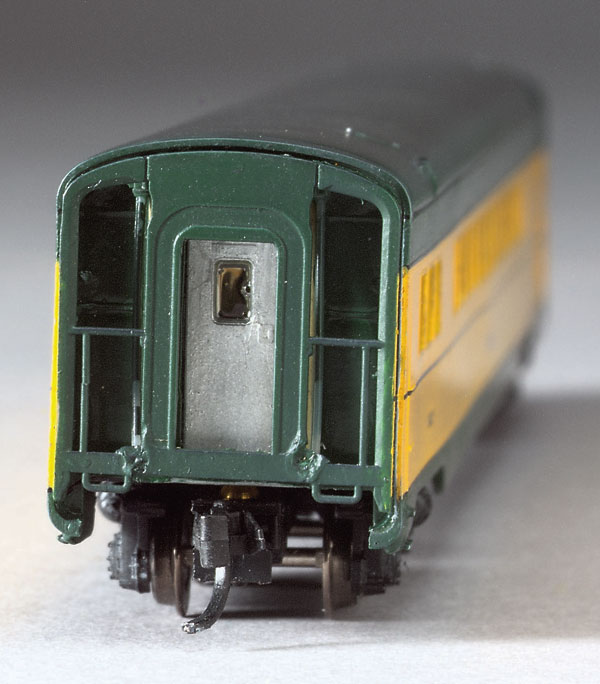Each kit is based on the American Limited 85-foot core kit which includes full-length injection-molded sides, roof, underbody details, trucks, standard diaphragms, and window glazing.
Des Plaines Hobbies also offers its operating full-width diaphragms as a separate kit that I used on this model.
Introduced in 1939 to replace heavyweight equipment, these gleaming streamliners competed with the Milwaukee Road’s Hiawatha and Burlington’s Twin Zephyr for passenger traffic between Chicago and Minneapolis-St. Paul. The C&NW named its train The 400 because the train traveled its 400-mile route in less than 400 minutes.
In 1958 the side skirts and full-width diaphragms were removed when the cars were rebuilt by Pullman-Standard. A simplified paint and lettering scheme was also introduced at this time that did not include the black stripes.
The Des Plaines Hobbies kits accurately match the dimensions in prototype drawings found in The Official Pullman-Standard Library Vol. 9: Chicago & North Western, by W. David Randall and William G. Anderson, published by Railway Production Classics. The baggage-tap-lounge matches car no. 7502 built for the Minnesota 400 in 1941. The other kits in the series match the original 400 equipment.
The instructions only cover assembly of the core kit without any specific information on detailing the 400 cars. Thus the drawings, photos, and lists in the P-S Library Vol. 9 book became my detailing guides.
The correct trucks are supplied in the kits. They’re nicely detailed and include separate brake cylinders. At first I followed the kit’s directions and press-fit the truck sideframes together. Over time the press-fit parts loosened up, so I used a hot soldering pencil to gently weld the parts together. Then I slipped in Atlas low-profile wheelsets.
I plan to run these cars as a train with minimal switching, so I used a Red Caboose Unimate II no. 1065 coupler on one end of each car. The other end has a Micro-Trains no. 1025 coupler. This coupler combination helps prevent unwanted uncoupling.
The sides of the cars look great with raised gaskets molded around each window. The window areas are recessed on the reverse side to bring the clear styrene glazing almost flush with the exterior surface of the side.
I assembled the body by gluing the roof, ends, sides, and skirts together with Tenax liquid cement. I also attached the outer cowling of the full-width diaphragms in order to get a smooth paint job later. Then I added a few extras such as grab irons and photo-etched brass stirrup steps from Gold Medal Models.
I glued pieces of HO 4 x 6 styrene strip inside to reinforce the joint where the floor meets the inside wall. This also helps the car hold its shape when the floor is snapped into place.
I airbrushed the interior with a light beige color, masking the outside of the body first to prevent any overspray. Then I masked off both the inside and outside of the car in order to paint the roof, ends, letterboards, diaphragms, and skirts Floquil CNW Green.
The window glazing was installed with Testor’s Clear Parts Cement. This cement dries clear and does not fog clear styrene.
Final assembly consisted of adjusting the trucks and couplers to work with the full-width diaphragms. I applied a little spray silicone with a brush to the outer faces of the diaphragms to reduce sideway friction.
These diaphragms operate flawlessly through a no. 6 crossover and on 15″-radius curves. They could be adjusted to operate on tighter curves, but I think I’d rebuild my layout before I’d give up the smooth, unbroken look of this train.
Thanks to Des Plaines Hobbies, it’s now possible to re-create a superb model of the Twin Cities 400, ready to begin its daily race against the competition.
Price: car kits, $26.95 each;
diaphragms, $5.95 a pair
Manufacturer:
Des Plaines Hobbies
1468 Lee St.
Des Plaines, IL 60018
www.desplaineshobbies.com
Description:
Injection-molded styrene undecorated passenger car kits
Product list:
DPN 1007 operating full-width diaphragms
DPN 1500 C&NW 400 baggage-tap-lounge
DPN 1501 C&NW deluxe 400 coach
DPN 1502 C&NW 400 coach with stewardess room
DPN 1503 C&NW 400 parlor car
DPN 1504 C&NW 400 diner

















